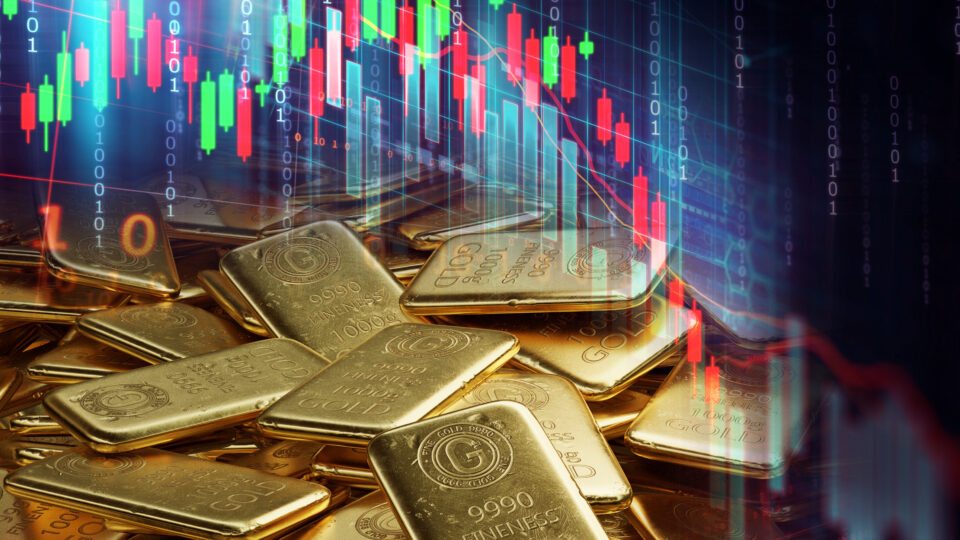Gold hit $2,146/oz on Monday, exceeding its previous all-time high by $65.
The spike was short-lived, as gold subsequently dropped back down to $2,030 per ounce — just below its previous peaks in August of 2020, March of 2022, and May of this year.
Gold’s breakout warrants investors’ attention. As always, gold’s performance is telling a story about the global financial system that might otherwise remain invisible.
Why is Gold Rising?
The primary technical drivers of gold certainly played a role in this rally.
Treasury yields have declined in recent months as markets factor in possible interest rate cuts in 2024. This week, the 10-Year Treasury yield slid down to 4.12%, down from 5.02% in October.
Fed officials have not yet committed to loosening monetary policy. But at their last policy meeting, they agreed they would proceed carefully and only raise interest rates if measures to control inflation fail.
The US dollar has also been weakening against other currencies, but still remains in a relatively strong position. A secular decline in the dollar would likely correlate with a long-term bull market in gold.
Dollar hegemony is at risk
Gold’s rally should make us seriously consider the growing risk of de-dollarization.
Federal Reserve Chair Jerome Powell recently stated that the fiscal path of the United States is “unsustainable” and that “we’ll have to get off that path sooner rather than later.”
There are two reasons why…
Runaway US government deficit
As we discussed in past weeks, The US government is running at an extreme deficit, with up to 15% of total tax revenues spent on interest payments alone. As long as taxes fail to cover government spending, the government must cover their expenditures by selling bonds.
This has worked for the last 50 years, during which time the US debt has risen from just over $400 billion at the end of the gold standard to over $33 trillion today.
As foreign governments reduce their reliance on the dollar, the US government will have fewer buyers for its debt. It will be forced to sell bonds with higher interest rates to attract buyers, which increases interest payments. As they continue to issue bonds to cover past debts, interest payments will eat up more and more of federal tax revenues, worsening the deficit.
This feedback loop was already set in motion this year, as the US government rolled over trillions of dollars of its debt at much higher interest rates.
BRICS move toward de-dollarization
BRICS countries (Brazil, Russia, India, China, and South Africa) are gaining traction as they attempt to move away from the dollar system. Russia is leading the way by using Yuan for 75% of its trade with China and 25% of transactions with other countries.
The challenge with de-dollarization is that no other country has a currency strong enough to fully replace the dollar.
The Chinese Yuan grapples with concerns about China’s economic transparency, capital controls, and geopolitical tensions, limiting global trust in its stability. The Russian Ruble has struggled since the beginning of the war with Ukraine. The Euro, shared by multiple nations in the Eurozone, faces challenges related to the economic disparities among its members, as well as questions about the long-term viability of the European Union.
Back to a gold standard?
It is unlikely that we will ever see the “classical” gold standard again, but the fact remains that gold is really the only possible replacement for the dollar. Nearly all nations already own it, and it requires no trust, treaties, or other political maneuvering for international trade.
In fact, the vast majority of recent gold demand has come from Eastern investors, not Western investors.
Central banks have been on a gold-buying spree this year, led by the People’s Bank of China, National Bank of Poland, Monetary Authority of Singapore, Central Bank of Libya, Reserve Bank of India, and many others. However, according to the World Gold Council, “reported gold reserves still account for just 4% of the bank’s total international reserves.”
If de-dollarization does significantly accelerate, the gold price would need to adjust significantly higher to carry even a small portion of the global economy.
As the Fed’s monetary tightening approaches its conclusion and the long-term viability of US fiscal policy becomes a subject of scrutiny among the world’s foremost economists (both foreign and domestic), the outlook for gold looks increasingly bright.
Secure gold savings, without the excess fees
Your weekly gold market commentary comes from our internal team of researchers and technical experts. Vaulted gives modern investors access to physical gold ownership at the best cost structure in the industry. With personal advising from industry experts and access to premier precious metals strategies, Vaulted is the key to life-long financial prosperity. Start protecting your portfolio today.
As always, thank you so much for reading – and happy investing!











